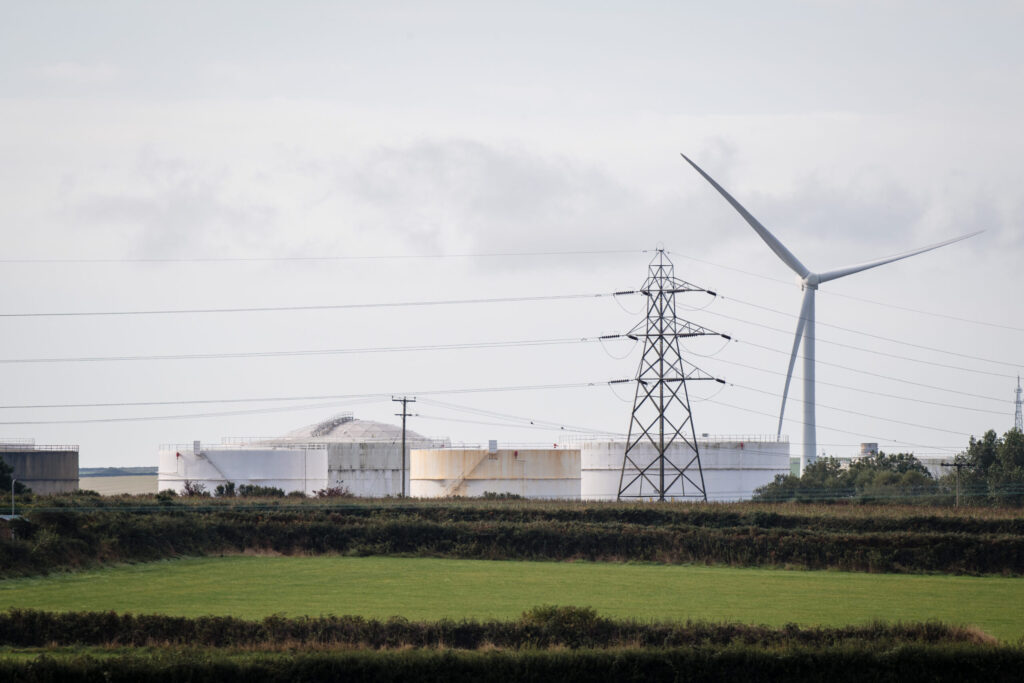Wanting more reliable access to backup fuel, natural gas companies in the U.S. are planning to add liquified natural gas storage tanks at their existing plants. Such storage is already being done in the UK and Germany. Here are storage tanks at the Dragon Liquefied Natural Gas plant in Wales. (Photo by Polly Thomas/Getty Images)
Tim Ryan served ten terms in the U.S. House of Representatives from 2003 to 2023. He serves as the Co-Chair of the Natural Allies for a Clean Energy Future Leadership Council.
As a lifelong Democrat and a Co-Chair for Natural Allies for a Clean Energy Future, I am eager to quickly develop a secure and practical energy policy that drives down global carbon emissions. We owe it to our children and grandchildren. And we have a moral obligation to be stewards of God’s planet. To abate the worst impacts of climate change, the impartial data and real-world success stories show we must partner the carbon-free power generation of renewables with the affordability, reliability, and security of low-carbon natural gas.
Recent commentary and short sighted attacks about me in the Ohio Capital Journal reflect the simplicity of bumper sticker slogans, even though our national energy infrastructure is far more complex. Serious people need to understand that. Cutting back on natural gas exports abroad to allied economies that need it, and turning off natural gas here at home, would be bad politics, destructive economics, and atrocious climate policy.
Without Natural Gas, More Coal Burning
Despite China installing solar panels and wind turbines at record capacity and six years ahead of schedule, the country burns more coal than the rest of the world combined to ensure grid reliability — building an average of two coal plants per week. That’s because mass buildout of renewable capacity alone cannot provide stable power needed to fuel its economy.
India’s coal consumption has also rapidly increased despite a 2030 target to achieve 50% of energy from non-fossil fuel sources. Even Germany, which has been a European leader in scaling up renewables, increased coal imports due to a lack of natural gas supply after the start of the war in Ukraine. The scale of these emissions, particularly in Asia, is staggering — and have obvious climate impacts here at home.
All in all, an energy policy without natural gas means 50% more greenhouse gas emissions from coal. For most countries, coal remains the only abundant and cheap source of energy to keep their developing economies running — even where renewables are scaling up quickly. We can wish this wasn’t so, but it is. And if we are to solve these problems, we need to be clear-eyed as we move forward.
Natural Gas is Bipartisan and Good Politics
Natural gas has growing bipartisan support — 69% of those surveyed in a new nationwide poll support increasing natural gas production and 76% want a steady transition to clean energy by using all options currently available.
Pennsylvania Governor, Democrat Josh Shapiro, has also embraced an all-of-the-above approach to the swing state’s energy future. He has remarked that Biden’s LNG pause, announced in January regarding the future of U.S. natural gas exports,“needs to be brief.” U.S. Senators Fetterman (D-PA) and Casey (D-PA) also raised concerns about the thousands of jobs at risk in their home state, one that is critically important this November.
Natural gas usage is skyrocketing in Ohio and has accounted for the largest share of Ohio’s in-state net generations since 2019, even as emissions have fallen dramatically over the last two decades. Our access to affordable and abundant natural gas will be a key factor in scaling up the electricity-hungry data centers needed to power the AI innovation race and technology superiority, key policy initiatives of the Biden Administration.
Natural Gas Ensures Affordability and Reliability
Natural gas is the most pragmatic solution for its reliability and affordability, powering about 40% of our electricity for homes and industry (double that of renewables), and accounting for two-thirds of America’s carbon emission reductions over the last 15 years. Despite natural gas being the most affordable and abundant energy source, heating homes and creating electricity, 25% of American households are still struggling to pay energy bills.
With a 60% increase in America’s power grid necessary to meet a renewables-only future, we must think about how hard-line policies financially impact struggling communities. We Democrats pride ourselves on championing the issues of the poorest among us. We cannot, therefore, jam unrealistic proposals down constituents’ throats that would only make their lives more difficult.
Greater Global Security with American Natural Gas
Some Democrats and most environmentalists who cheered on Biden’s LNG export pause fail to address what happens next. American natural gas today has the best environmental technology, safeguards, and regulations than any other leading country. Cutting off access for allies means forcing them instead to rely on more hostile nations like Russia for natural gas. Russia has no regard for our environment. They have fewer environmental safeguards, particularly around methane, and are destabilizing global security and democracies.
Democrats need to lead on practical energy policies. Ones that have broad political support that can survive these tumultuous times and make a big impact in reducing carbon by further displacing coal here and around the world. We can, and should, embrace carbon-free power — wind, solar, hydro, nuclear — and do it alongside natural gas. This election is too important to get the politics, the economics, and the climate benefits wrong.
SUPPORT NEWS YOU TRUST.
GET THE MORNING HEADLINES DELIVERED TO YOUR INBOX
The post To make progress on climate, Democrats must partner renewables with natural gas appeared first on Ohio Capital Journal.

